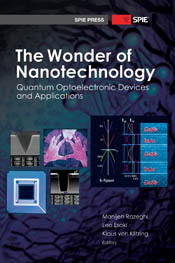Nov 22 2013
Nanotechnology research has progressed into quantum-level systems where electrons, photonics, and even thermal properties can be engineered, enabling new structures and materials with which to create ever-shrinking, ever-faster electronics.
The Wonder of Nanotechnology: Quantum Optoelectronic Devices and Applications, edited by Manijeh Razeghi and Nobel Laureates Leo Esaki and Klaus von Klitzing, focuses on the application of nanotechnology to modern semiconductor optoelectronic devices. The book is published by SPIE, the international society of optics and photonics.
 The recently published The Wonder of Nanotechnology: Quantum Optoelectronic Devices and Applications, is edited by Manijeh Razeghi, Leo Esaki, and Klaus von Klitzing.
The recently published The Wonder of Nanotechnology: Quantum Optoelectronic Devices and Applications, is edited by Manijeh Razeghi, Leo Esaki, and Klaus von Klitzing.
The volume is a compilation of research papers from the International Conference on Infrared Optoelectronics at Northwestern University's Center for Quantum Devices in September 2012, developed into chapters representing state-of-the-art research in infrared materials and devices.
"Advances in material science at the nanometer scale are opening new doors in the area of optics and electronics. The ability to manipulate atoms and photons, and fabricate new material structures offers opportunities to realize new emitters, detectors, optics, ever-shrinking electronics, and integration of optics and electronics," writes Nibir Dhar, program manager with Defense Advanced Research Project Agency (DARPA), in an essay in the book. "Imaging technology has the opportunity to leverage these developments to produce new products for military, industrial, medical, security, and other consumer applications."
The editors of Wonder of Nanotechnology are:
- Manijeh Razeghi, director of the Center for Quantum Devices at Northwestern University and one of the leading scientists in the field of semiconductor science and technology. Razeghi pioneered nanometer-scale architectures in semiconductor technology, and her research in quantum materials has culminated in various technologies such as type-II strained-layer superlattice infrared detectors, lasers, and terahertz technology. Her current interest is in nanoscale optoelectronic quantum devices.
- Leo Esaki, who shared the 1973 Nobel Prize in Physics for his discovery of the phenomenon of electron tunneling while working at Tokyo Tsushin Kogyo (now known as Sony). He is known for his invention of the Esaki diode, which exploited that phenomenon. He also pioneered the development of the semiconductor superlattice while at IBM, and is president of the Yokohama College of Pharmacy in Japan.
- Klaus von Klitzing, director of the Max Planck Institute for Solid State Research in Germany. Von Klitzing was awarded the 1985 Nobel Prize in Physics for his discovery of the integer quantum Hall effect. His current research focuses on the properties of low-dimensional electronic systems, typically in low temperatures and in high magnetic fields.
"The chapters in this book bear witness to how far we have come since the invention of manmade semiconductor superlattices in 1969," Esaki writes in the book's foreword. "I look back with wonder at all of the exciting developments of the last 44 years and can only imagine where the future will take this technology and what exciting discoveries await."
The book's editors also address the inspiration of nature in studying nanoscale structures, and how the human ability to control material composition on the nanometer scale is what allows us to achieve technological goals transcending the properties of naturally occurring materials.
"The wings of a butterfly, the feather of a peacock, the sheen of a pearl -- all of these are examples of nature's photonic crystals: nanostructured arrangements of atoms that capture and recast the colors of the rainbow with iridescent beauty," von Klitzing writes in the book's preface. "As our tools to manipulate matter reach ever smaller length scales, we, too, are able to join in the game of discovery in the nano-world -- a game that nature has long since mastered."
Notable chapters include:
- "Advances in High-Power Quantum Cascade Lasers and Applications" by Arkadiy Lyakh, Richard Maulini, Alexei Tsekoun, and Boris Tadjikov (Pranalytica, Inc.), and CO2-laser inventor Kumar Patel (Pranalytica, Inc., and University of California Los Angeles)
- "Type-II Superlattices: Status and Trends" by Elena Plis and Sanjay Krishna (Center for High-Technology Materials, University of New Mexico)
- "Quantum Dots for Infrared Focal Plane Arrays Grown by MOCVD" by Manijeh Razeghi and Stanley Tsao (Center for Quantum Devices, Northwestern University)
- "Quantum-Dot Biosensors using Fluorescence Resonance Energy Transfer (FRET)" by James Garland and Dinakar Ramadurai (Episensors, Inc., and Sivananthan Laboratories, Inc.) and Siva Sivananthan (Sivananthan Laboratories, Inc., and University of Illinois)
- "Nanostructured Electrode Interfaces for Energy Applications" by Palash Gangopadhyay, Kaushik Balakrishnan, and Nasser Peyghambarian (College of Optical Sciences, University of Arizona).
SPIE is the international society for optics and photonics, a not-for-profit organization founded in 1955 to advance light-based technologies. The Society serves more than 235,000 constituents from approximately 155 countries, offering conferences, continuing education, books, journals, and a digital library in support of interdisciplinary information exchange, professional networking, and patent precedent. SPIE provided over $3.2 million in support of education and outreach programs in 2012.